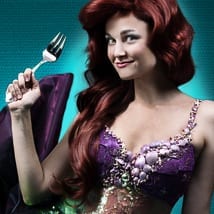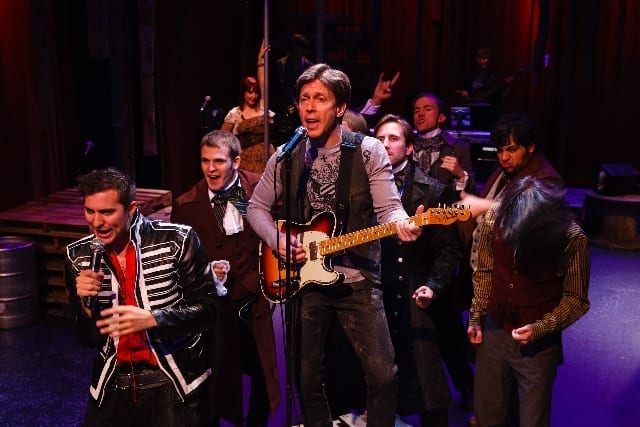WEST VALLEY CITY — In the hearts of Disney aficionados, The Little Mermaid holds a special place in animated history. After a string of mediocre animated films, this film (based on a Hans Christian Andersen tale) was the first of a string of hits that reached an apex with The Lion King. Beloved for over two decades, this story of mermaids, fish, magic, and a shipwreck is a difficult tale to transfer to the stage. Yet, the Hale Centre Theatre has never been known to shirk from a technical challenge, and this production has all the magic needed to do justice to the play’s source material.
Under the directorial vision of John J. Sweeney, The Little Mermaid is a start-to-finish visual spectacular. Sweeney understood that the key to the success of a stage adaptation of a film is often the degree to which the play can wow the audience. In this respect, The Little Mermaid exceeds any realistic expectations. Kacey Udy‘s set design caught the deep ocean hues of Adam Flitton‘s lighting designs and effectively created an undersea mood for the production. Even the back walls and railings were decorated in an ocean motif; the only way that Udy could have made his set more immersive would be to remove the carpet and seats and replace them with blue tiling and seashell-shaped chairs.
Even more dazzling, though, were Tamara Baker and Jennifer Stapley Taylor‘s costume designs. Baker and Stapley added spangles and bling to almost every ocean creature’s costume, with many being almost unbelievably eye-popping. Contrasted with the more muted tones of the humans, it was easy to see why Sebastian would think that life under the sea was so much more appealing than an existence on land. Baker and Taylor also conveyed an elegance in the royal courts on both land (in the contest and in Prince Eric’s smart vests) and on sea (through the Mersisters’ sleek dresses).
As the title character Bre Welch‘s excitement and fascination with the human world is contagious. Welch’s superb ability to infuse her character with curiosity is vital because it drives the story and makes Ariel’s highly endearing. Additionally, Welch has the clear, strong voice capable of to handling the score, and her performances in “Part of Your World” and “Beyond My Wildest Dreams” were highlights of the evening. As Prince Eric, Jon Rose was able to handle the difficult task of building a love story with a woman who didn’t have any lines with him. Rose turned on the charm in “One Step Closer,” and it made Eric’s desire to kiss Ariel the next day much more believable.
Despite the best efforts of the cast, the show falls far short of perfection, mostly because of Doug Wright’s script. Somehow, in the process of adding an hour of material to the film script to create the stage play, Wright removed any trace of personality from most of the supporting characters. This hampered almost all of the other cast members’ efforts to create multidimensional performances. For example, instead of an overworked and frazzled civil servant, Sebastian (played by David K. Martin) was a vaguely sketched character whose overriding traits were a great singing voice and an inability to follow the girl he had been assigned to keep an eye on. The only character who emerged unscathed from Wright’s script revisions was Ursula. In Brooklyn Pulver Kohler’s portrayal, Ursula was a motivated, slighted sister of King Triton who wasn’t merely bad for the sake of being evil. Rather, she yearned for power and to regain the kingdom that she felt was rightfully hers. Kohler avoided any hint of bitterness in her character by mixing Ursula’s evil with some sass. The result was an innovative take on an old Disney villain, which will surely please many longtime fans.
Sweeney himself provided suitable direction, with the strongest moments coming in the show’s most famous songs, “Under the Sea” and “Kiss the Girl.” In these songs (written by Alan Menken and Howard Ashman), Sweeney ramped up the spectacle and turned the play into a full-blown extravaganza. Nevertheless, he did not neglect the new songs (with music by Menken and lyrics by Glenn Slater); “One Step Closer” had a quiet emotional tenderness that was easy to appreciate, for example. I also enjoyed the excitement and elation in Ariel during “Beyond My Wildest Dreams” and the feminine cuteness of her sisters’ choreography (by Geoffrey Reynolds) in “She’s In Love.”
However, Sweeney fell into the trap that many directors at the Hale Centre Theatre are susceptible to: relying too heavily on the Hale’s rotating stage floor. Quite frankly, standing around and singing as the stage rotates is still standing around, and the best blocked songs in The Little Mermaid didn’t use this trick at all, including “Poor Unfortunate Souls” and “Positoovity.” Additionally, if overused in a show, the rotating floor becomes less special, and its full impact is reduced in critical moments (such as in “Kiss the Girl”).
Nevertheless, the positives far outweigh the negatives in The Little Mermaid. The cast and crew at the West Valley Hale have made their best efforts to overcome the show’s built-in flaws, and the result is satisfying. In the end, the leading couple’s charm, a familiar score, and the fantastical visual displays are unforgettable, and the doubts I have about this production are as ethereal as sea foam. Children, nostalgic adults who watched the film repeatedly as a child, and families looking for a wholesome outing will certainly be satisfied with The Little Mermaid.






